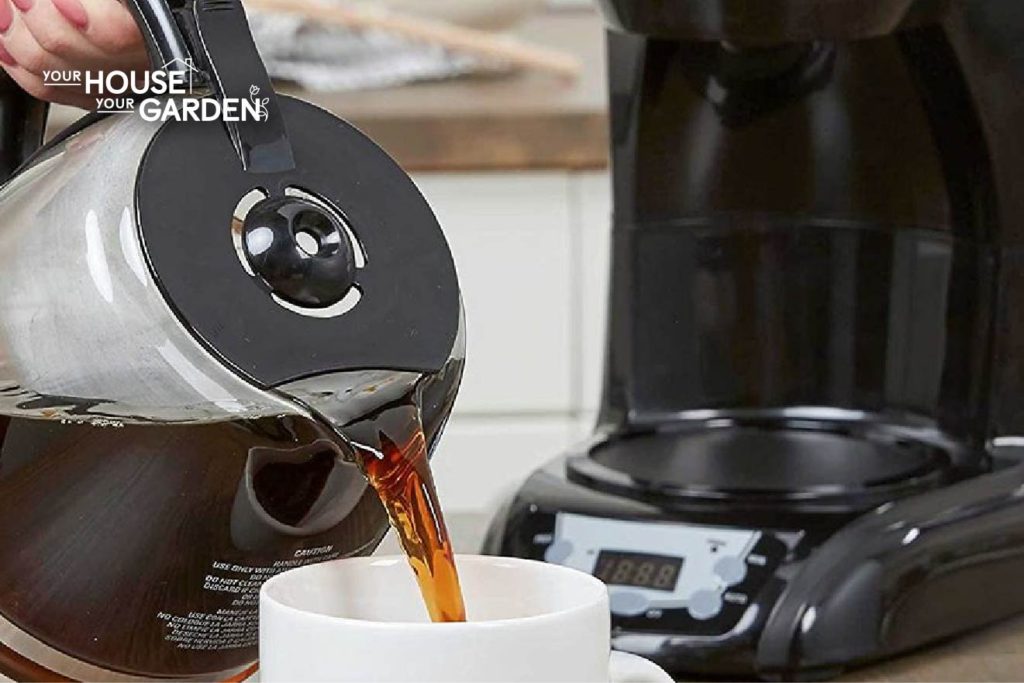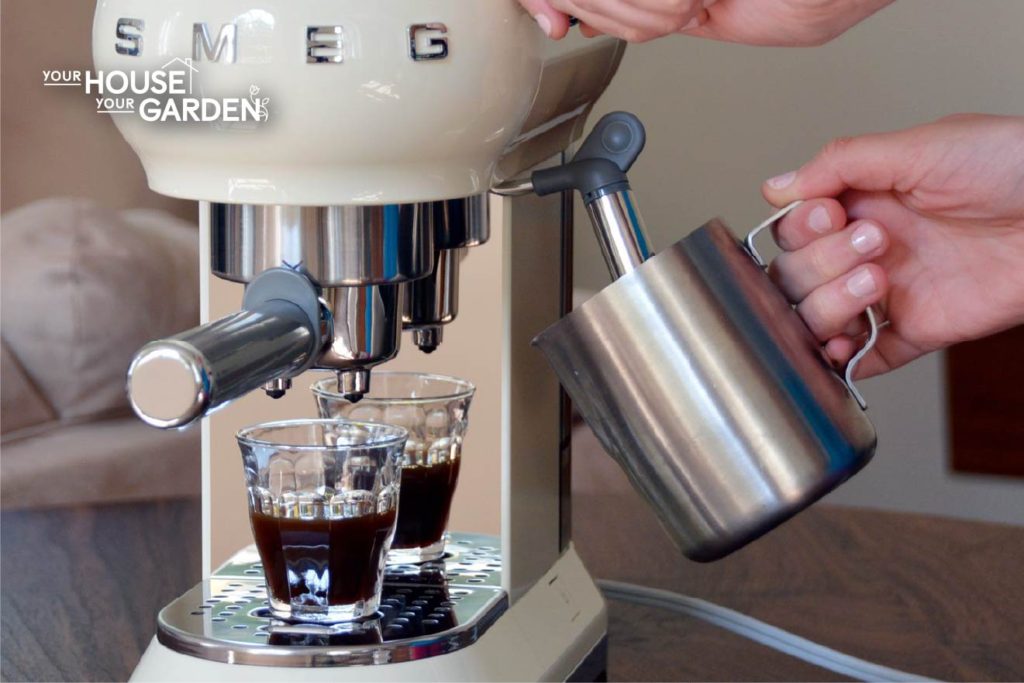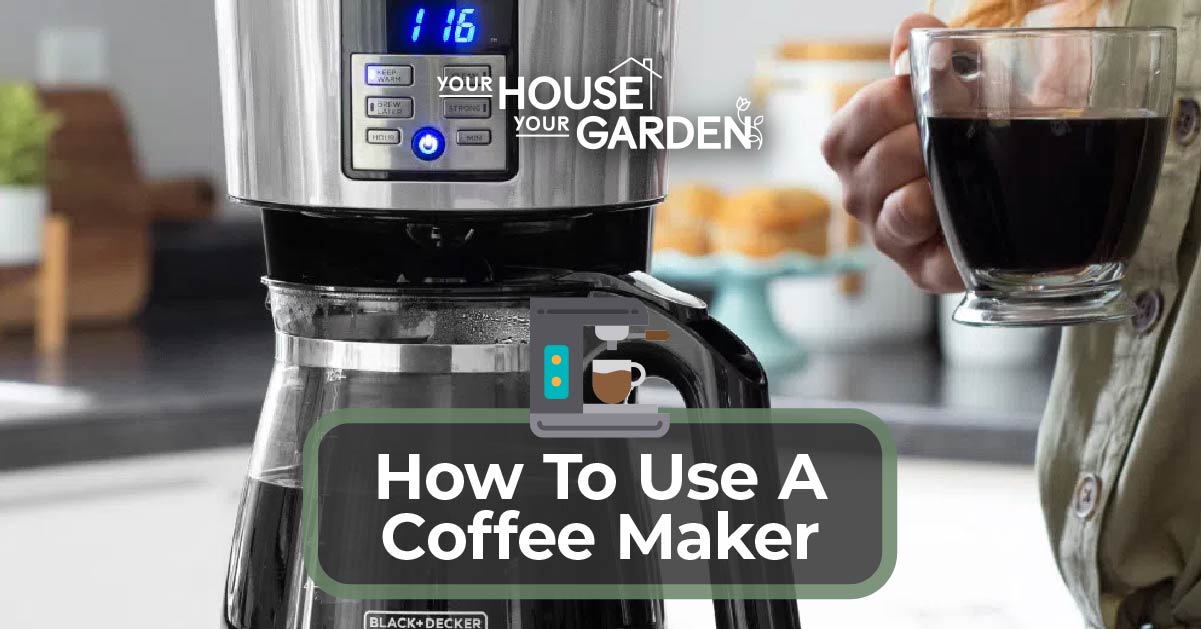Using a coffee maker involves the following steps: add a filter to the filter basket, place ground coffee beans in the filter, measure out the appropriate amount of water, fill the coffee maker with water, close the lid, and press start.
What is a coffee maker? Coffee makers are small electric kitchen appliances that brew hot pots of coffee automatically. To learn more about how to work a coffee maker, refer to our in depth coffee maker use guide below.
1. Add a Filter To the Filter Basket
The first step to using your coffee maker is placing a filter inside the filter basket. If you’re using a standard drip coffee maker, you’ll use regular paper filters. Paper filters are both highly absorbent and finely woven, meaning they’re able to remove excess oil and stop fine grinds from passing through.
Not all paper filters are the same and they come in different sizes. Coffee filter sizes are measured on a scale of 1 through 6, with each number corresponding to a different size of coffee pot.
For example, while number 1 filters are designed for single-cup coffee makers, number 4 filters fit all 8 – 12 cup coffee makers. In case you’re wondering, there’s no functional difference between white and brown filters.
Some coffee makers come with a reusable metal filter. These are made out of fine stainless steel mesh and must be cleaned after every use.
2. Grind Coffee Beans and Place Grinds Into Coffee Filter
Next, pull out your preferred brand of coffee and measure out the appropriate amount of beans. How much you use will depend on how many cups you’re making and how strong you want it. On average, 7.5 – 10 grams of dried coffee beans will produce one cup of coffee.
Once you’ve measured out the coffee beans, place them in your grinder, close the lid, and press start. When the process has ended, unplug the grinder and pour the coffee grinds into the coffee filter.
If you don’t like grinding coffee, remember that packs of pre-ground coffee are available for purchase.
3. Fill the Coffee Maker With Water
Now that you have your coffee grinds in place, the next step is filling the back of the coffee maker with water. How much water you use will depend on how many cups of coffee you plan to make.
The easiest way to measure out the water is by using the coffee pot. All coffee pots come with markings showing how much water is equal to how many cups. Always add a half cup extra as some of the water will evaporate during the heating process.
4. Close the Lid and Press Start
When the water has been added, close the lid, and press start. Most drip coffee makers will take around five minutes to brew a pot of coffee, although this varies depending on make, model, and how much coffee you’re brewing.
5. Enjoy Your Coffee and Clean the Coffee Pot
When the brewing process has finished, pour yourself a cup and enjoy the freshly brewed coffee. When you’re done, remove the pot from the heating element and give it a rinse plus quick wash. Before you put your coffee maker away, be sure to remove the filter and used coffee grinds.
If you have a reusable metal filter. Give it a quick rinse/wash.

Coffee Maker Tips for Efficiency and Taste
When using a coffee maker, there’s a few tips and tricks to keep in mind for improved efficiency and coffee taste.
Don’t Leave Pot On Heating Element For Too Long: A common mistake people make is leaving the coffee pot with leftover coffee on the heating element. Although this won’t damage the glass pot, it can cause the coffee to become caked to the inside, making it difficult to clean.
Don’t Reuse Filter: Some people try to reuse coffee filters; don’t. Paper coffee filters are made for single use and must be thrown away after each use. Cloth coffee filters are an exception to this and are designed to be used more than once.
Use the Right Water: The type of water you use can have a significant impact on the taste of your coffee. For example, hard water with lots of minerals can make it hard for coffee particles to bind with the water molecules. That said, soft or distilled water – which is water stripped of magnesium and calcium – also makes for a bad batch of coffee. Instead, you want water somewhere in between.
Main Steps and Mistakes Of Coffee Maker Usage
Using a coffee maker can be broken down into the following steps:
- Placing a filter into the filter basket.
- Measuring out and grinding coffee beans.
- Placing coffee beans in the filter.
- Measuring out the appropriate amount of water and pouring it into the back of the coffee maker.
- Closing the lid and pressing start.
Many of the best coffee makers come with programmable presets, a timer, and a built-in water filter. These extra features may change the usage steps.
Does the Coffee Maker Type Affect the Usage Stages?
Yes, the coffee maker type affects the usage stages. So far, we’ve covered the automatic drip coffee maker, but several other kinds exist, including:
French Press: A French Press is a manual coffee maker that uses a glass cylinder and a plunger mechanism.
Pour-Over Coffee Maker: Similar to a drip coffee maker, a pour over coffee maker contains a filter and body. Ground coffee beans are placed in the filter and hot water is poured over top.
Aeropress: Similar to a french press, an Aeropress employs a chamber and a plunger mechanism and is used to make both hot and cold coffee.
Stovetop Coffee Maker: Stovetop coffee makers look similar to a kettle and receive heat from a stove top burner.
Cold Brew: Uses immersion to produce a potent cup of coffee. Most models have a built-in mesh filter.
Percolator: Considered by many to be the original coffee maker, percolators cycle hot water through coffee grinds until the desired strength is reached.
Espresso Machine: Uses hot water and pressure to create small, highly concentrated, cups of coffee.
As we can see, the different coffee maker types have distinct usage stages and change depending on which one you use.
When To Prefer a Coffee Maker Over An Espresso Machine
Coffee Makers are preferable to espresso machines when you want to make several cups of coffee at once. Additionally, espresso is a highly concentrated form of coffee and isn’t to everyone’s liking.
When it comes to the question of coffee maker vs. espresso machine, it depends what kind of coffee you want to make and what strength you’re after.
Alternatives Uses of a Coffee Makers for Other Uses Besides Brewing Coffee
Although coffee makers are predominantly used for brewing coffee, they can be used for a number of other things as well. To learn more about the different coffee maker uses, refer to the sections below.

Use a Coffee Maker as a Kettle
To use a coffee maker as a kettle, follow these steps:
- Use the coffee pot to measure out the amount of water you wish to heat up.
- Pour the water into the back of the coffee maker.
- Close the coffee maker, make sure it’s plugged in, and press start.
Essentially, you’re following all the same steps you would follow normally while using a coffee maker, but don’t add any ground coffee beans.
Use a Coffee Maker as a Steamer
Because coffee makers are not designed to produce steam, they can’t be used as a steamer.
Use a Coffee Maker as a Soup Maker
To use a coffee maker as a soup maker, follow these steps.
- Place soup ingredients inside the coffee pot.
- Measure out the amount of water the recipe calls for.
- Pour water into the back of the coffee maker.
- Close the lid and press start.
When done this way, the soup cooks inside the coffee pot as hot water is added. Another advantage of cooking soup in a coffee maker is the heating element keeps the soup warm long after it has finished cooking.

